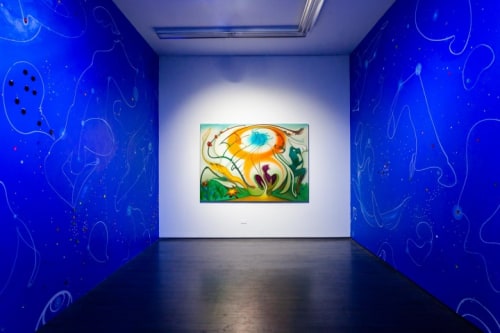CHICAGO — “A map of the world that does not include Utopia,” quipped Oscar Wilde, “is not worth even glancing at.” Inka Essenhigh’s Uchronia at Kavi Gupta gives us not a map, but fragments and glimpses of a place and time better than our own. Unlike past visionaries who imagined utopia as a faraway place, Essenhigh conjures an incomplete image of a distant future whose contours, however, are clear: It is a world of ecological balance, a pastoral place where what was once work is now play.
Essenhigh’s paintings glow with brilliant enamel colors. Extravagantly bending and swooping lines animate depictions of invented trees and flowers. She begins her paintings by whirling brushstrokes on a blank canvas. Deriving the composition from those initial markings, the paintings have a fluid quality; the vegetation is inviting yet uncanny, dreamlike — almost like it’s underwater.
While Essenhigh’s artistic process begins intuitively, her intuition is strongly informed by art history. The two untitled murals in the smaller of the gallery’s two rooms clearly reference Miró, in both its fields of brilliant blue and the amoeba-like shapes that populate the picture plane. Likewise, “welcome to the Gather-n-Hunt” (2017), with its sizzling colors and strong central horizontal figure, framed by foliage, owes much to the Matisse of “Le Bonheur de Vivre” (1905). In “Living Room 2600 C.E.” (2019) a foreshortened figure floats in midair, feet toward us; the position is reminiscent of a cherub painted on a trompe l’oeil baroque ceiling. But the show isn’t all art history. Essenhigh is a cultural omnivore, and her images owe as much to the covers of vintage science fiction novels as they do to the masters of modern and baroque painting, while the anthropomorphic frying pan and measuring cup in “Kitchen, 2623 C.E.” (2018) could have come from Disney’s Beauty and the Beast.
Uchronia also reveals Essenhigh as remarkably literary. Her painting “The Blazing World” (2019) is titled after English writer Margaret Cavendish’s utopian 1666 novel The Description of a New World, Called the Blazing-World, and each of Essenhigh’s paintings is accompanied by a short narrative locating the work in an imagined future history, describing the scenes and activities as an anthropologist or historian might. Together, the texts read like fragments from an encyclopedia yet to be written.
“Welcome to the Gather-n-Hunt” is the show’s most overtly pastoral image. Just as the hard work of shepherds was converted to play in Renaissance pastoral art and literature, Essenhigh converts the early struggle for survival into a pastime in her future. “Nostalgia for our terrestrial history,” reads the text accompanying the painting, “inspired the Gather-n-Hunt, a family restaurant pantomiming the subsistence strategies of our Mesolithic ancestors.” Idealized bodies pass a framing threshold into a special, secluded space. They are greeted there by a ghostly figure — a hologram? — with the bowed head and flowing garments of a Madonna. Once in the pastoral space they cavort in trees gathering fruit or pursue beasts in the background, recalling the hunters in early cave paintings. The scene is not entirely benign, though: the ambiguous form of an unknown creature roasts on a spit at the center, and another bound figure is clearly humanoid: faun-like, it has a fox’s tail and wears a bikini top. Whatever urges our future pastoral gratifies, they include something violent within us.
“Living Room” also revels in pastoral imagery: a pair of shoes in the foreground and a doorway in the background are the only signs that the scene takes place indoors. Otherwise, it is one of luxuriant vegetation and cavorting humans. What does this apparently artificial nature imply? Has the world outside become uninhabitable? Have people lost the will to venture outdoors? And what of the childlike figure reaching for the enormous, round red fruit hanging from the tree that dominates this dream garden? It is too visually striking, and bears too much resemblance to the apple that led to the fall from Eden, to be ignored. Hints of sin and exile haunt the painting, as does the sentiment et in Arcadia ego — even in the ideal world there is death.
“New Jersey” (2019) presents another pastoral landscape — horizontal, green, rich with fanciful vegetation, a fantastic city gleaming on the horizon. Here the human presence is implied: instead of figures, we see habitations, small hillocks with golden light pouring from windows. One door stands ajar, showing an interior and a pair of shoes, recently cast off by the inhabitant it seems. It’s an imagined future, yet like so many works addressing a time that has yet to come, it’s also about the present, a land of comfortable, verdant suburbs that is eerily empty, perhaps filled with private pleasures, but devoid of public space or community.
The nine panels of “Fragments from a Nature Cult” (2019) are pieces of a single implied image. Most show luxuriant vegetation, but here and there we see parts of a green, possibly female, body — a hand, a partial foot. The wall text tells us of a possible nature goddess cult from “the late period of the information age.” As welcome as such an ecological movement might have been, the fragmentary nature of the image suggests that something terrible has happened to it, its images lost to a slow decay or sudden act of iconoclastic violence. Utopia, it seems, is fragile.
For all the hints of menace at its margins, Uchronia remains a refreshingly positive vision. In a time when it is easier to imagine an end of the world itself than an end of its innumerable problems, we need utopian visionaries, even if they see only glimpses and fragments.
Inka Essenhigh: Uchronia continues at Kavi Gupta (835 West Washington Blvd., Chicago, Illinois) through August 24.

